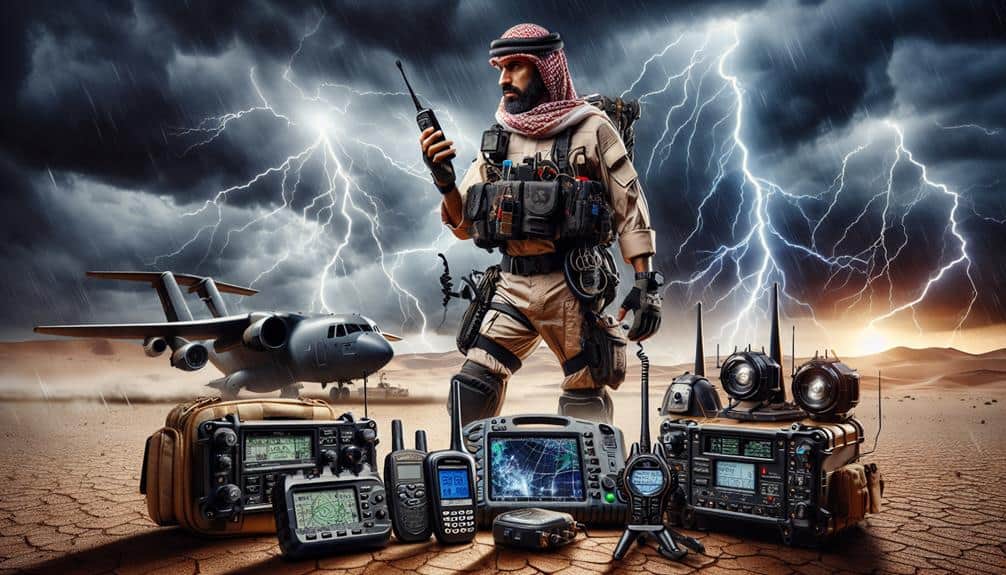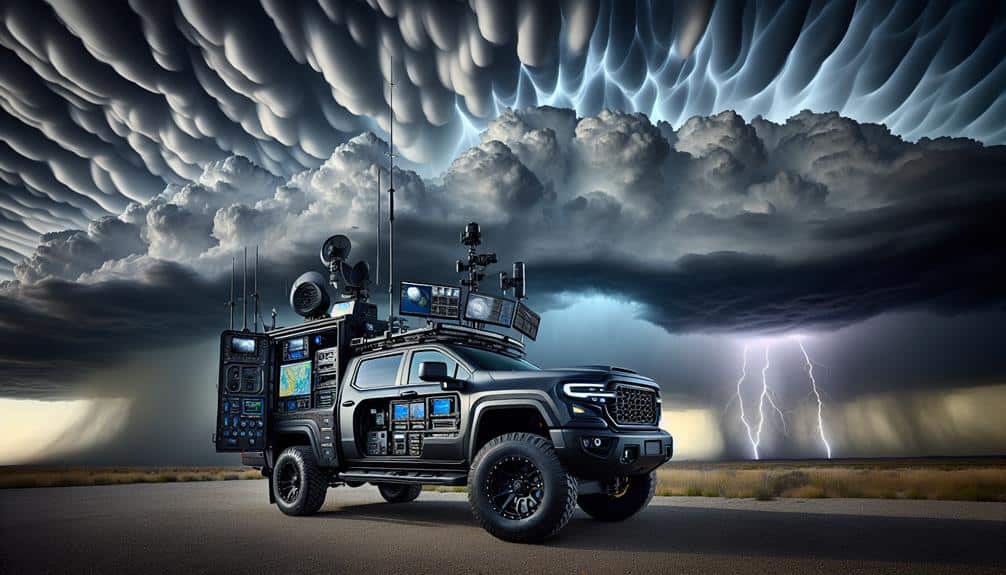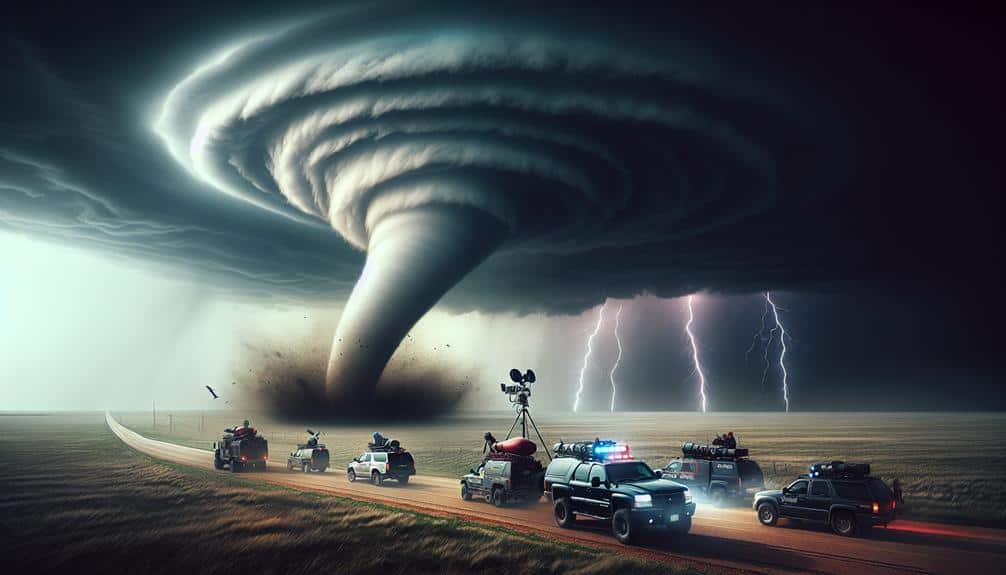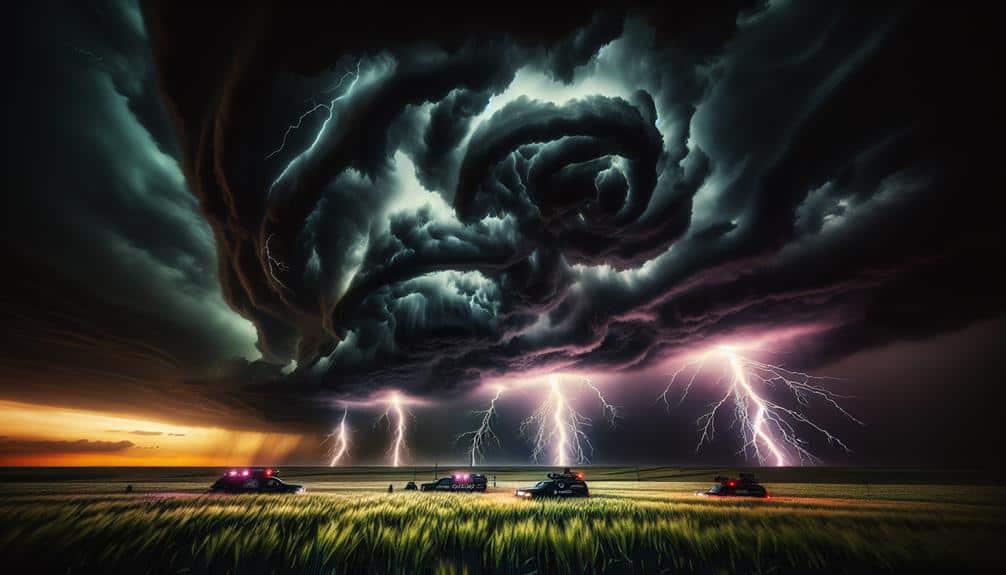To excel in storm chasing competitions, we need dependable weather radar for precise tracking, high-definition cameras for detailed data, and strong GPS navigation for real-time adjustments. Our vehicle must withstand hazardous conditions, equipped with integrated radar and GPS technology. Effective emergency tools and satellite communications are critical for safety and coordination. Wearing high-visibility, protective gear minimizes risks. Thorough data logging guarantees accurate meteorological readings and real-time analytics, preventing data loss and device failures. With this specialized equipment, we can maximize performance and safety while chasing storms efficiently. Join us as we explore these essential tools and strategies.
Key Points
- Utilize reliable weather radar for real-time storm tracking and data analysis to ensure safety and informed decisions.
- Equip high-resolution cameras with stability accessories for capturing detailed storm images and enhancing forecasting accuracy.
- Install GPS navigation systems with durable route software and real-time data integration for effective storm movement monitoring.
- Carry emergency and satellite communication tools to maintain connectivity and receive critical updates in remote areas.
Reliable Weather Radar
Dependable weather radar is vital for storm chasing competitions as it enables us to accurately track and predict storm movements in real time. When we talk about radar accuracy, we're referring to the precision with which our equipment can identify the location, speed, and intensity of storm cells. This accuracy is important because it directly impacts our storm tracking capabilities. The better our radar, the more effectively we can navigate towards the most intense parts of a storm while ensuring our safety.
Weather pattern analysis is another key aspect. By examining historical and real-time data, we can identify trends and anomalies that could indicate the development of severe weather. This analytical approach allows us to make informed decisions quickly and efficiently, optimizing our chances of capturing the most dramatic storm footage.
Our reliance on reliable equipment can't be overstated; any failure in our radar system could mean missing out on critical data or, worse, encountering unexpected hazards.
In storm chasing, freedom comes from the ability to predict and adapt. With accurate radar and thorough weather pattern analysis, we maximize our chances of a successful chase while minimizing risks. Dependable weather radar systems are, thus, essential tools in our storm-chasing arsenal.
High-Resolution Cameras
Let's focus on the high-resolution cameras essential for storm chasing. They provide critical image quality, even in low light conditions, and must include robust weather resistance features.
Image Quality Importance
In storm chasing competitions, the use of high-definition cameras is crucial for capturing detailed and accurate data that can greatly enhance analysis and forecasting abilities. By employing advanced photography techniques and leveraging powerful editing software, we can extract crucial insights from each image.
High-definition cameras enable us to capture fine details of storm structures, which are essential for predicting storm behavior and ensuring safety.
To maximize image quality, we need to address several key elements:
- Camera accessories: Utilizing tripods and stabilizers minimizes motion blur, ensuring sharp images even in turbulent conditions.
- Lighting setup: Proper lighting techniques, including the use of external flashes, can significantly improve image clarity, especially when natural light is variable.
High-definition imagery isn't just about aesthetic appeal; it's about precision and the ability to discern subtle changes in storm dynamics. By focusing on these technical aspects, we grant ourselves the freedom to push the boundaries of storm analysis and improve our forecasting models.
Let's harness this technology to its fullest potential in our storm chasing endeavors.
Low Light Performance
High-resolution cameras excel in low light conditions, allowing us to capture important storm details even during the night or in poor visibility. To optimize our equipment for such scenarios, precise control over exposure settings is essential. Balancing ISO, aperture, and shutter speed ensures the sensor captures the maximum amount of light without introducing excessive noise.
We often prefer a wide-aperture lens choice, like f/1.4 or f/1.8, to allow more light into the camera, enhancing image clarity.
Tripod stability plays a crucial role in low-light photography. Using a high-quality tripod minimizes camera shake, important for long exposure shots that reveal intricate storm structures. Additionally, cameras equipped with advanced image stabilization technology further reduce the risk of blur, providing us with sharp, detailed images even in challenging conditions.
Data shows that cameras featuring larger sensors, such as full-frame, perform better in low light by capturing more light per pixel. This capability allows us to document storm patterns and activity with high fidelity, offering an unfiltered glimpse into nature's raw power.
Weather Resistance Features
When selecting high-resolution cameras for storm chasing, we prioritize weather resistance features that guarantee durability and functionality in extreme conditions. Our cameras must endure relentless rain, powerful winds, and flying debris without compromising image quality.
As a result, we focus on three vital attributes that secure our equipment remains operational in the heart of the storm.
- Waterproof Construction: Securing our cameras have a waterproof construction is non-negotiable. This feature protects the internal electronics from water infiltration, which is essential when capturing storms that produce torrential rain.
- Windproof Design: A windproof design is essential for maintaining stability and performance. High winds can disrupt the camera's focus and alignment, so we need models that are specifically engineered to withstand strong gusts without faltering.

Accurate GPS route systems are vital for storm chasers to precisely monitor and forecast storm movements. We depend heavily on GPS precision and strong signal quality to guarantee we're in the correct place at the correct time.
In storm chasing contests, every moment is important. A deviation of even a few meters can indicate the distinction between capturing innovative footage and missing the event entirely. Hence, high precision in our GPS systems is non-negotiable.
We've discovered that durable route software, regularly updated, greatly enhances our ability to traverse swiftly changing weather conditions. These updates guarantee that maps, routes, and storm prediction models are current, reducing the risk of errors. The best systems integrate real-time data, giving us the liberty to adjust our routes dynamically.
Furthermore, signal strength is essential when navigating remote areas where storms frequently appear. Advanced GPS units with improved signal reception sustain connectivity even in regions with limited cellular coverage, guaranteeing we don't lose our way.
Durable Storm Chasing Vehicle
Our storm chasing vehicle's durability is essential to guaranteeing we can navigate hazardous conditions safely and efficiently. We need a sturdy system that can handle rough terrains and sudden weather changes. Off-road capabilities are vital, allowing us to pursue storm paths that traditional vehicles can't manage.
Additionally, vehicle modifications like reinforced exteriors and upgraded suspension systems are crucial to withstand heavy rains, strong winds, and flying debris.
To enhance our storm tracking efficiency, our vehicle must be equipped with technology that provides real-time updates. This includes advanced radar systems and GPS integration, ensuring we're always informed about the storm's trajectory and intensity. Data-driven insights are essential for making split-second decisions, maximizing our chances of capturing critical footage while maintaining safety.
Here's what we prioritize in our storm chasing vehicle:
- Reinforced exteriors: Protects against debris and extreme weather conditions.
- Advanced suspension systems: Ensures stability and maneuverability on unpaved roads.
Emergency Communication Tools

Effective emergency communication tools are essential for maintaining contact with our team and emergency services during storm chasing expeditions. The unpredictable nature of storms demands reliable communication channels. Traditional cell networks often fail under severe weather conditions, so we must integrate satellite phones into our gear. Satellite phones operate independently of terrestrial cell towers, providing us with continuous connectivity.
According to recent data, satellite phones have a 99.9% global coverage rate, guaranteeing we can send and receive critical information regardless of location.
In addition to satellite phones, emergency beacons are indispensable. These devices, specifically Personal Locator Beacons (PLBs), transmit our location to rescue services via satellite. When activated, a PLB sends a distress signal that includes GPS coordinates, reducing search and rescue response times to a significant extent. The average PLB activation leads to a response within 90 minutes, a critical factor when every second counts.
Integrating these tools enhances our operational efficiency and safety. As storm chasers, we thrive on the liberty to explore extreme weather, but we can't underestimate the importance of robust communication systems. By leveraging satellite phones and emergency beacons, we guarantee our adventures remain thrilling yet secure.
Safety Gear and Apparel
Equipping ourselves with cutting-edge safety gear and specialized apparel is necessary for minimizing the risks associated with storm chasing. By prioritizing safety first, we can guarantee not only our well-being but also maintain a high level of performance optimization during competitions.
Our approach should be data-driven and analytical, focusing on protective clothing and gear comfort to enhance our efficiency and freedom in the field.
Key items to take into account include:
- Protective Helmets: These are essential in preventing head injuries from flying debris, which is common in severe weather conditions. Helmets should meet ANSI/ISEA Z89.1 standards for maximum protection.
- High-Visibility Jackets: Ensuring we're easily seen by fellow chasers and emergency personnel is important. Jackets should be reflective and weather-resistant to provide both visibility and comfort.
Optimizing our gear involves selecting items that balance safety, comfort, and performance. By investing in high-quality protective clothing, we can chase storms with confidence, knowing we've minimized the risks and maximized our operational capabilities.
Data Logging Equipment

Utilizing advanced data logging equipment is necessary for capturing accurate and thorough meteorological data during storm chasing competitions. We'll need to guarantee our equipment is in excellent condition, emphasizing equipment maintenance to prevent any unexpected failures in the field. Regular checks on sensors, data loggers, and other essential components will minimize downtime and maximize data collection efficiency.
Battery life is another vital factor. High-capacity batteries and portable power solutions guarantee our devices operate throughout the storm chase. We should monitor battery levels rigorously and carry backup power sources to avoid disruptions in data logging.
Data storage is a pivotal aspect of our operations. High-speed, high-capacity storage devices will allow us to record immense amounts of data without lag. Implementing redundancy, such as RAID configurations, can safeguard against data loss.
Remote access to our data logging systems can provide real-time data analytics and facilitate immediate decision-making. Using a robust communication setup—like satellite internet or mobile networks—enables us to transmit data back to a central server, where it can be analyzed by support teams.
Frequently Asked Questions
What Are the Best Times of Year for Storm Chasing Competitions?
We should target the spring and early summer months for storm chasing competitions. Weather patterns during these peak seasons optimize our chances. Effective team dynamics and competition strategies are vital for maximizing our success during these periods.
How Do You Find and Join Storm Chasing Teams or Groups?
To find and join storm chasing teams, we examine team dynamics through recruitment channels, assess equipment requirements, and leverage networking opportunities at meteorological conferences. Our data-driven approach guarantees we align with teams valuing freedom and technical proficiency.
What Kind of Training Is Needed for Novice Storm Chasers?
We can't emphasize enough—novice storm chasers need extensive simulation practice and rigorous safety protocols. These training sessions provide hands-on experience with storm patterns, forecasting, and emergency response, ensuring we're prepared for real-life storm chasing adventures.
How Do You Predict the Path of a Storm Accurately?
We analyze weather patterns using advanced technology to predict storm behavior. By applying sophisticated forecasting techniques, we can accurately determine a storm's path, allowing us to chase safely and maximize our freedom in the field.
What Are the Legal Considerations and Permits Required for Storm Chasing?
Finding a path through the legal maze for storm chasing is essential. We need to understand permit requirements and legal considerations, ensuring our actions don't infringe on local laws. Knowledge is power; let's chase storms with informed freedom.


